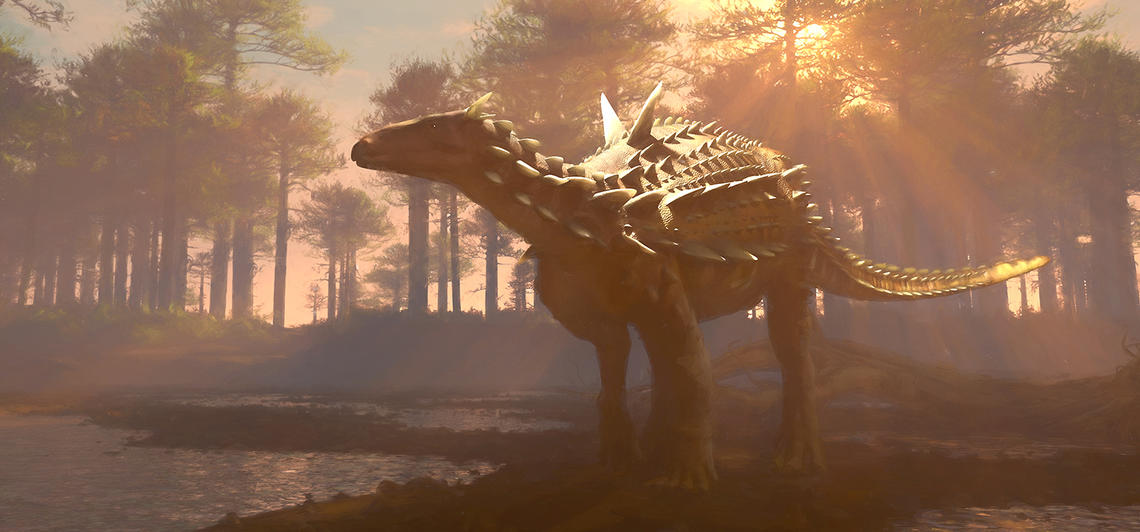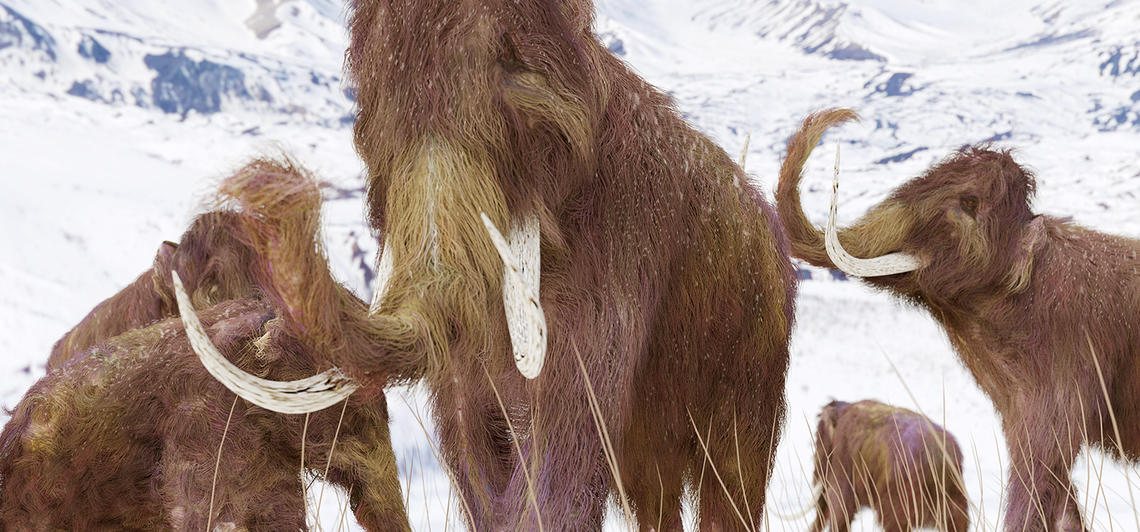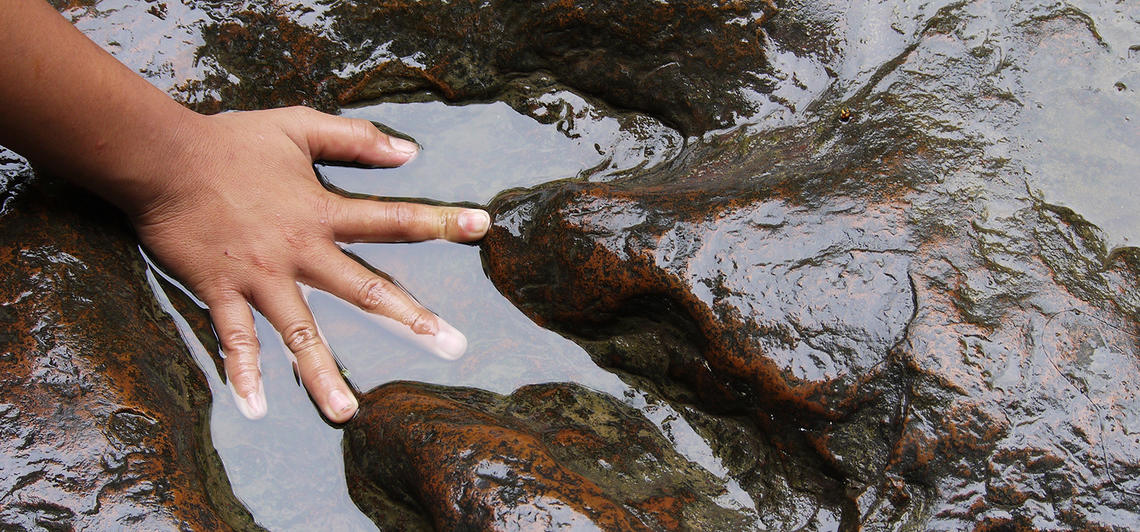
Dinosaurs roamed the Earth until about 65 million years ago.
Aug. 20, 2017
The details of the origins of Earth, and the impact humans have had on our planet, are researched and studied all over the world every day. Humans have overcome many challenges since arriving on the scene, but there are many still ahead – global concerns such as climate change, overpopulation, food shortages, and other issues arising from a changing planet.
With so much ahead of us, it’s important to understand how we got here. How can the study of early life on Earth shape the future? What can dinosaurs tell us about modern-day species? Can pre-historic data help design current climate-change models? University of Calgary researchers are at the forefront of new discoveries and insights that help us to not only appreciate and understand where we’ve come from, but also to prepare us for the future.
Before humans, before mammals, before dinosaurs, even before multi-celled organisms, there were microbes. At three-and-a-half billion years old, single-celled microbes are the oldest lifeforms on Earth. The Earth of their time would have looked extremely different. The atmosphere would have lacked oxygen. Torrential rains and huge lightning storms would have brightened the sky while bacteria would have covered most of the Earth’s surface.
Slowly, these microbes began using the tools they had – carbon dioxide, water, and the sun’s energy – to generate their own food, producing oxygen in the process. The introduction of oxygen changed the Earth’s atmosphere and, in turn, allowed new oxygen-breathing organisms to develop.
Over millions of years, single-celled bacteria evolved into eukaryotic cells (cells with internal “organs”) and eventually split into three groups that became the early ancestors of plants, fungi, and animals. It was not until approximately 230 million years ago – over 3.25 billion years after the first signs of life – that dinosaurs began to roam the Earth.

Dinosaurs roamed the Earth until about 65 million years ago.
As the Earth’s ecosystems shifted, the rise of dinosaurs brought new species to Earth’s lands, oceans, and skies, until they were wiped out in a mass extinction event about 65 million years ago. Now, the impact and evidence of dinosaurs can be found all over Alberta, home to the richest source of dinosaur fossils in the world.
Darla Zelenitsky, principal dinosaur researcher in the Department of Geoscience at UCalgary’s Faculty of Science, discovered her love for dinosaurs at the age of four. Since then, she has dedicated her life to dinosaur paleontology (solving the mystery of the world’s largest dinosaur egg along the way) and is now working in Japan, providing new insight into the lives of dinosaur species that lived in the region 110 million years ago.
When you think of fossils, you may not immediately think of Japan, which is part of the appeal for Zelenitsky. “I think what is exciting about working in Japan is the fact that dinosaur fossil sites are relatively uncommon there. There are only about 20 dinosaur localities there, so very little fossil material is known from the country.”
Searching in new sites brings the hope of new discoveries. Zelenitsky and her team are looking to find behavioural links and similar features between theropod dinosaurs and birds, their modern-day descendants. Many features still found in birds, such as the wishbone and feathers, were inherited from their dinosaur ancestors. By discovering which bird-like behaviours or features remain from the dinosaur days, we can better understand how birds evolved and how these features helped them thrive.
Paleontologists not only look to uncover the past but also use history to help save and protect current and future species. By looking at the fossil record in a given area, researchers can get a clearer picture of the biology and behaviour of the dinosaur species that lived there. Studying how and why these creatures died can give us ideas on how to tackle current global problems.
“Changes in climate and its effects on species in the past, for example, can give us insight into present-day issues related to climate change and species extinction,” says Zelenitsky. “The ability to be involved in research that helps solve mysteries related to how these magnificent creatures lived and died is really exciting.”

Once dinosaurs were extinct, mammals grew much larger.
When dinosaurs ruled the Earth, mammals were just beginning to evolve and split into the wide variety of species we know today. When a mass extinction event approximately 65 million years ago wiped huge numbers of species, including dinosaurs, the way was cleared for the rise of mammals, who would go on to dominate Earth.
After finding a fossil in her backyard as a young child, Jessica Theodor, associate professor of ecology and evolutionary biology in UCalgary’s Department of Biological Sciences, was hooked.
Now focusing her research on the state of the Earth over the past 65 million years, Theodor is looking to see how the ancestors of modern-day mammals survived and evolved after dinosaurs went extinct. Between the predatory nature of the major carnivorous dinosaurs and the dominance of herbivorous dinosaurs, there was little left to go around for the small, usually nocturnal mammals. “As soon as the dinosaurs go extinct, all of a sudden we get bigger mammals,” says Theodor. “We get things that are larger than a bear and into the rhino size category very, very quickly after dinosaurs are gone.”
The study of how mammals adapted to these historical changes in their ecosystem is critical when trying to predict how current species will react to global climate change. Every species has an ideal home, proper food, and climate, which promote its sustainability, while shifting conditions lead to losses of habitat and possible extinction.
Theodor’s team explores the long-term effects of some of those changes. “How do organisms respond to major climate changes?” she says. “Can we make any generalizations that help us to predict things in the future? If you look at all the climate modelling that goes on, a lot of those models are tested using data from the fossil record to see if they fit. What we offer that is different from studying how mammals are changing now is a much longer time span that we can look at, and repeated events in the fossil record of changes in climate.”
As the world tries to make decisions to combat the effects of climate change and understand how these effects will change our world, research like Theodor’s is invaluable.

Humans are relatively recent in Earth's history.
Studies of the earliest humans (Hominins) try to bring light to how our direct ancestors lived, what their families were like, and how they were interconnected to their environment. The first evidence of early human life began approximately two million years ago, with many different variations of early humans developing before homo sapiens evolved and became the most prominent “human” on Earth.
Julio Mercader, associate professor of anthropology and archaeology in UCalgary’s Faculty of Arts, studies the lives of early human communities in East Africa. For example, using the newest in microscopic technologies, Mercader and his team were able to determine when these humans began eating complex diets consisting of both plants and meat. This combination of food may show early evidence of humans adapting to their surroundings by changing their food source, says Mercader. “Meat and plants come together as a way to solve environmental problems. For example, drying environments, drought.”
Mercader finds excitement in his area of study due to the huge amount of technological advancement, making it possible to find microscopic clues that would never have been found 20 years ago. “Microscopic evidence attached to the stone tools that they were using is giving us insight into tool use, resource exploitation, environmental context and diet all at once,” says Mercader. “New molecular fingerprinting techniques that will allow us to squeeze the data out of the fossils as much as possible. I think that some of the things we do today in my lab were pretty much unthinkable 10 years ago or 15 years ago, like being able to place a timeframe for the onset of complex diets.”
Working in Africa and interacting not only with other scientists and colleagues but with the local community and the public gives Mercader a deep appreciation for the collaborative efforts it will take to answer questions the world needs to answer. “I guess the lesson really is that if you want to have an evidence-based solution to problems coming up, these can only be done together and together means the western scientist and non-western scientist, archaeologist and the local community.”
With his expertise in environmental archaeology and human ecology, Mercader sees ways of using historical records of ancient human crops to combat future hunger crises. The crops that were popular in human diets in the recent past are no longer part of modern agriculture.
“There is an entire universe of lost crops that used to be consumed by humans that are not consumed anymore,” says Mercader. With more and more detailed information on how ancient humans ate and grew their food, modern communities facing drought or food shortage may be able to resort back to the foods of our ancestors.

The first evidence of human life emerged about two million years ago.
The Earth has come a long way since the days of single-celled bacteria. It has flourished with plant and animal species of all shapes and sizes and now feeds and sustains over seven billion homo sapiens. With that growth has come a range of new challenges. Changes in climate are the cause of natural phenomenon all over the world including droughts, storms, and floods, as well as unexpected and unpredictable changes in both micro and macro ecosystems.
With these challenges mounting, governments, scientists, and the private sector have all begun to envision what human life would look like on other planets, including the possibility of inhabiting Mars in the near future. NASA looks to send humans to Mars by 2030, and private companies like SpaceX have hopes of sending people to the Red Planet as early as 2024. Ideas once only thought of in science fiction are now becoming a reality.
Humans have always been good at finding new ways to survive, but this fact is not without consequence. “For me understanding what the world was like before people were on it is a really utterly fascinating thing,” says Theodor. “It's important because if we're going to understand how to manipulate the ecosystem so that we can continue to live in it, then we need to understand how it worked when we weren't here.”
Research that scientists are conducting today is helping to use our past as a way of predicting and understanding our future. While studying our human ancestors, Mercader sees that adapting and finding new ways to live is something humans have always done. “I find nothing more human than adapting to a challenging new place, new environment, new food,” he says, “so that's why I study what I study because it really strikes at the heart of a fundamental question which is – what makes us human?”
Whether humans remain on Earth or expand to other nearby planets remains to be seen, but one thing is certain: humans must continue to adapt and learn from their history, or they will become the history themselves.
– – – – –
Participate in a research study
– – – – –
Dr. Darla Zelenitsky, PhD, is an assistant professor and principal dinosaur researcher in the Department of Geoscience at the University of Calgary. Her research lab uses various approaches to reconstruct and examine changes in the biology and behaviours of extinct species, and is NSERC supported. Read more about Darla
Dr. Jessica Theodor, PhD, is an associate professor of Ecology & Evolutionary Biology in the Department of Biological Sciences at UCalgary. Her current investigations in ecology, evolutionary biology, and paleobiology focus on understanding the causes of organismal diversity patterns found over geologic time. Read more about Jessica
Dr. Julio Mercader, PhD, is an associate professor in the Department of Anthropology and Archaeology at UCalgary. Julio’s interest in human evolution and tropical ecosystems has taken him to the Democratic Republic of Congo, Equatorial Guinea, Cameroon, Ivory Coast, Mozambique, Zimbabwe, and Tanzania. Read more about Julio